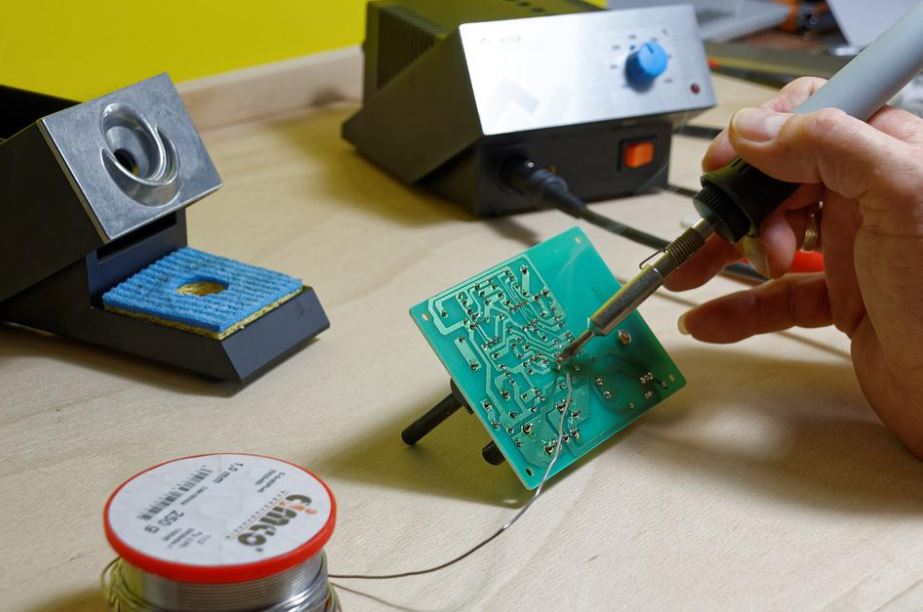You understand that soldering iron is the critical tool to have when you know how to solder. You are aware that there are various types of soldering irons available in the market to choose from. You are looking for a comprehensive guide that explains all the things you need to consider when purchasing a soldering iron.
If this is the case, then keep reading!

In this post, we are going to have a detailed overview of the tips to consider before buying a soldering iron, general FAQs about soldering iron and much more.
So let’s get started without anymore delay!
Tips to Consider Before Buying a New Soldering Iron
1. Try to Avoid Soldering Irons that Have Fixed Temperatures
To differentiate between a good soldering iron and a bad one, it is important that you understand the basics of soldering. Along with that, knowing the mechanics of soldering is critical to make an informed decision during the soldering iron purchasing process.
A perfect soldering iron not only provides heat for the soldering process, but produces it in a precisely controlled way.
There is no doubt that you have to deal with a variety of components and different types of solders when soldering. Different solders require different temperatures. For this specific reason, a good soldering iron must have granular control on the tip temperature.
Mistake in this particular aspect leads to cold solder joints or burnt components. Hence, avoid purchasing entry level soldering irons that don’t have temperature adjustment control if you want to do a clean joining work. A soldering iron with preset temperature would heat the tip to the exact set amount and in most cases, won’t maintain the heat long enough. With no way to figure out the temperature level, it is impossible to deliver consistent soldering results.
2. Get Proper Knowledge on Wattage and Temperature Control
Here’s an important thing to note. The manufacturer advertised wattage denotes that how fast the heating component of the iron can increase the tip temperature. We’ll give you an example.
Let’s say that a soldering iron is advertised as 25 watts. So it’ll approximately take over a minute to bring the tip to above the 600 degree F range from the room temperature. And on the other hand, a soldering station rated at 130 watts would hardly take 3 seconds to get there.
You need to know that soldering isn’t just heating the tip of the soldering iron to the required temperature. The heating element and the tip of the iron works together till the time you fully complete the job.
If you take up a delicate soldering job with smaller components, then even a 25 watt iron can do well.
However, when you take up a large soldering job, you must have a high-wattage soldering iron to do a clean job of joining the components with high-thermal mass.
A smaller soldering iron cannot cope up with the requirements of a large job. And also, a low power iron won’t be able to maintain the tip temperature for a long time, resulting in cold joints. In order to avoid this scenario, it is important to have a high-power soldering iron for joining high-thermal mass components.
Contrary to the popular notion, a high-powered soldering iron won’t damage delicate components. A high-wattage soldering iron is designed with temperature control system, meaning that the heater will automatically stop when the tip reaches the preset temperature. The powerful heating system makes sure that the iron gets quick thermal recovery during demanding soldering jobs.
Related: Difference Between Soldering Guns vs Soldering Irons
3. Understand the Importance of Thermal Response Time
Responsiveness is pretty important for effective soldering. If your soldering station has 130 watts but the iron tip gets cold quickly before the heater starts functioning, then there is no use of your soldering station having 130 watts of power.
A classic example would be cheap analogue soldering irons. They have a slow thermal response time and they won’t be able to equalize the sudden loss of tip temperature when you are handling large soldering job. Like we’ve mentioned earlier, this leads to you getting cold joints.
A good soldering iron can easily tackle this problem thanks to their digital closed loop temperature control system. They are seriously quick in restoring the tip temperature when a sudden temperature loss is experienced due to a large soldering job.
The reason for their quick response time is that they are equipped with heating element, temperature sensor and a microprocessor control unit.
Many modern-day soldering irons are starting to incorporate microprocessor-based temperature control system to maintain consistent tip temperature even when soldering high-thermal mass components.
4. Learn the Differences between Traditional and Direct Soldering Irons
You must understand that not all digital soldering irons built equally. Both cheep and high-end soldering stations may have the microprocessor temperature control system, but the soldering performance is significantly higher in the high-end models.
Many modern-day soldering stations also employ direct heating technology, which is superfast responsive for sudden thermal changes and maintains the tip temperature consistently over a considerable amount of time.
Tip design also plays a major role in temperature maintenance. Some modern-day traditional soldering irons separate the tip from the closed loop temperature control system. In fact, the tip slides on and off the heating element and there are certain sensors used to sense the tip temperature.
Although it looks fantastic, make sure that the tip and the heating element doesn’t have air gap between them. Air is a poor conductor of heat, and when you have air gap between the tip and the temperature monitoring system, it makes it impossible for the sensor to record the temperature changes of the tip.
Understand the difference between the traditional and direct heating soldering irons and based on your knowledge, purchase the one that suits your needs.
Related: How to Use a Soldering Iron? A Thorough Guide
Conclusion
There you have it! Our guide on the tips to consider before purchasing a soldering iron would have provided you clear answers for all your questions.
There are several options available when it comes to purchasing a soldering iron, so keep your soldering needs in mind before purchasing one for yourself.
Want to share your thoughts? Put them in the comments section below!
FAQs on Soldering Irons
What are the Types of Soldering Equipments Available in the Market?
There are actually several types of soldering equipments available in the market. They include.
- Soldering irons.
- Soldering stations.
- Soldering guns.
- Soldering pastes.
How to Clean and Maintain a Soldering Equipment?
It is critical that you clean and maintain the soldering equipments to prolong its lifespan. Most of the soldering equipments can be cleaned using general cleaning methods. The simplest way to clean the iron tips is to wipe the build-up of debris during the previous sessions.
Take a careful look at the tips for the residual solder and carbon build-up. Keep a wet sponge near you and after heating the iron, gently wipe off the solder.
This way, you can effectively clean and maintain the soldering iron.



